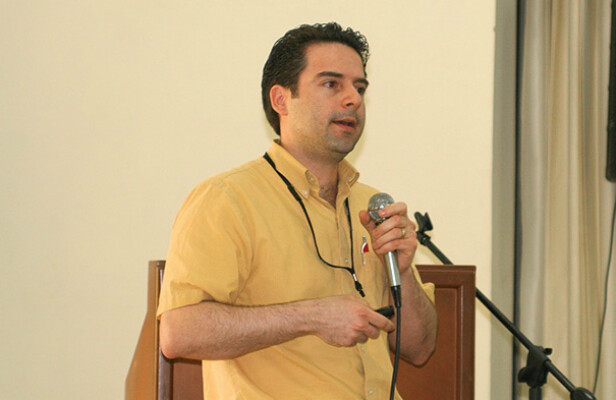Penn Vet Lends Expertise to Improve Colombian Cattle Producers’ Livelihoods
Cattle in the United States are generally managed to either produce milk or to produce beef. However, in most of the world, cattle are counted on to do both in what are called dual-purpose production systems.
This is especially true in Colombia, where the University of Pennsylvania’s Victor Absalón-Medina recently traveled to meet with veterinary and animal science students, faculty, agricultural professionals and producers. Emphasizing a holistic management approach based on sound nutrition and assisted reproduction strategies, his aim is to promote cross-institutional collaborations to help local farmers keep their animals healthy, productive and profitable.
Absalón is director of the recently established Gamete and Embryo Manipulation Laboratory in Large Animals in Penn’s School of Veterinary Medicine at the New Bolton Center Campus. He earned a veterinary degree from the Universidad Veracruzana, Mexico, and holds M.S. and Ph.D. degrees from Cornell University in tropical livestock management and in assisted reproduction technologies in dairy cattle, especially in vitro embryo production.
It was based on this expertise and history of collaboration with other universities that Absalón was invited to the Palmira campus of Universidad Nacional de Colombia, or UNAL, in April to give a keynote address for an intensive short course and workshop, titled “Land Use, Cattle Systems and Community Livelihoods in Colombia.” The event was sponsored by Colombia’s Fulbright Commission, Colombia’s national science foundation, known as Colciencias, and Michigan State University. This Fulbright-Colciencias project is led by MSU’s Robert W. Blake and Carlos Vicente Durán from UNAL.
The focus of Absalón’s talk was on ways to improve the energy intake and reproductive potential of cattle raised in production settings with frequently occurring energy deficits, such as those in tropical America.
In his work on large animal assisted reproduction, Absalón closely considers factors that can influence the health and productivity of an animal, such as the role of nutrition. At the workshop, he introduced attendees to nutritional tools, such as the Cornell Net Carbohydrate and Protein System, or CNCPS, which accurately predicts animal nutritional requirements and associated metabolic statuses based on the animal’s age, physiological status, environment, activity and, critically, the caloric and nutritional composition of its food.
“For example, let’s say an adult cow is in her first month after birth and is producing milk,” Absalón says. “There are energy requirements just to keep her alive, but then she also has extra energy requirements to make milk and to recover from birth.”
During his graduate program, Absalón studied dual-purpose cattle systems in the Gulf region of Mexico utilizing the CNCPS model. A key finding was that cows of all ages in the final trimester of gestation, which lasts nine months, didn’t consume nearly as many calories as they expended. As a result, cows were forced to sacrifice their welfare by relying on their own energy reserves. Besides directly reducing milking performance, this outcome increased the risk of postpartum uterine and mammary infections and hampered subsequent reproductive performance.
This nutritional shortfall is further exacerbated in young cows who are pregnant and producing milk for the first time. If they don’t receive adequate nutrition, their growth, lifetime productivity and health may be constrained. In these scenarios, the mother is basically competing with her fetus for nutrients.
At the end of gestation, Absalón says, not only is the fetus growing exponentially, but the cow also has heightened nutrient needs to prepare the mammary gland to supply her offspring with colostrum and her owner with milk.
A similar situation prevails in Colombia’s pasture-based systems and Absalón believes using the CNCPS model could pay dividends for cattle owners.
“An important task is to demonstrate to professionals and producers the value of such tools in evaluating management options to consistently meet animal energy and protein demands in all physiological stages of productive life, and to do so efficiently in order to improve profitability,” Absalón says.
The workshop at UNAL was complemented by a public event in collaboration with a leading delegation of Colombia’s National Cattle Producers Federation. Through interactions with producers, the veterinarians and other professionals in attendance recognized that a key first step in the effort to maximize both animal health and producers’ profits would be to establish a tropical feedstuff “library.” This database would compile locally available food sources, and would provide information about the foods’ caloric and nutritional composition so producers could enhance their animals’ diets in a sustainable and profitable way.
Attendees at the workshop and public event also noted that a second crucial step will be to apply the CNCPS to predict and then monitor animal performance.
Absalón hopes that both milestones will be achieved by collaborating across institutions to train veterinarians and technicians who can continue to conduct research into animals’ continuously changing requirements for growth over their lifetime.
Equipping veterinarians and other animal science professionals with tools to help farmers to better manage their cattle will increase both herd productivity and economic output, as cattle produce more milk or meat and require less veterinary intervention, Absalón says. The expected result is better livelihoods and quality of life for farmers and their communities, as well as for consumers.
Looking ahead, Absalón plans to establish a partnership between Penn Vet and UNAL as well as other institutions to promote exchange and learning opportunities for students.
“The students and faculty with whom I spoke were excited about this holistic approach to production and are anxious to improve the competitiveness of the Colombian cattle sector,” Absalón says. “I’m hoping this is just the first step in an eventual long-term relationship.”








